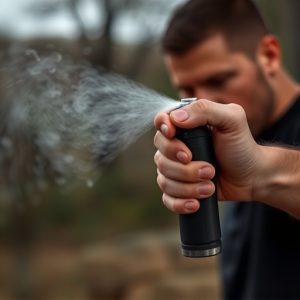Law Enforcement Pepper Spray: Storage, Maintenance, and Replacement Guide
Pepper spray, a crucial less-lethal force tool for law enforcement, requires strict adherence to sto…….
Pepper spray, a crucial less-lethal force tool for law enforcement, requires strict adherence to storage regulations and shelf life management (2-5 years) to maintain effectiveness. Proper storage conditions, including temperature control (50°F-80°F/10°C-27°C), humidity, and protection from direct sunlight, are essential to prevent degradation. Regular inspections for damage, leakage, and expiration dates (typically 1-3 years) are vital to ensure optimal performance when needed, protecting both officers and bystanders. Following manufacturer guidelines for storage and maintenance ensures pepper spray remains a reliable tool.
“In the realm of law enforcement, pepper spray is a critical non-lethal weapon that requires strategic selection, proper usage, and meticulous care. This comprehensive guide delves into the legal considerations surrounding pepper spray, offering insights on its effective deployment. We explore the process of choosing the right pepper spray weapon, emphasizing factors like agent concentration and delivery mechanisms. Additionally, we dissect essential aspects of storage and maintenance to ensure its longevity. Learn about crucial shelf life considerations, as understanding when to replace your spray is vital for optimal performance and safety.”
- Understanding Pepper Spray: A Legal Perspective
- Choosing the Right Pepper Spray Weapon for Law Enforcement
- Storage and Maintenance: Ensuring Effectiveness
- Shelf Life Considerations: When to Replace Your Spray
Understanding Pepper Spray: A Legal Perspective
Pepper spray, a powerful non-lethal weapon, has become an integral part of law enforcement strategies worldwide. From a legal standpoint, its use is tightly regulated to ensure public safety and accountability. Understanding the legal perspective on pepper spray involves comprehending its classification as a less-lethal force tool, subject to specific guidelines and restrictions. These regulations dictate how law enforcement agencies acquire, store, and deploy pepper spray, ensuring it remains an effective deterrent without causing excessive harm.
Storage and shelf life are critical considerations in the legal context. Pepper spray must be securely stored, often in designated safe or locker, with strict access controls to prevent unauthorized use or tampering. The shelf life of pepper spray varies based on manufacturing standards and storage conditions, typically ranging from 2-5 years. Law enforcement agencies must maintain accurate records, including purchase dates and expiration dates, to ensure compliance and promptly replace stocks once they reach their end date, maintaining the integrity and effectiveness of their non-lethal force arsenal.
Choosing the Right Pepper Spray Weapon for Law Enforcement
When selecting a pepper spray weapon for law enforcement, officers must consider various factors to ensure its effectiveness and safety. One crucial aspect is the shelf life and storage requirements of the pepper spray. Different brands and types have varying expiration dates, so it’s essential to choose a product with a sufficient lifespan that aligns with the agency’s needs. Proper storage conditions, including temperature and humidity control, are equally vital to maintain the spray’s potency.
Officers should opt for pepper spray products that offer clear instructions on storage and handling, typically provided by the manufacturer. This includes knowing the recommended shelf life, which can range from 2 to 5 years, depending on the formulation and packaging. By adhering to these guidelines, law enforcement agencies can guarantee that their pepper spray weapons remain potent and ready for use when needed.
Storage and Maintenance: Ensuring Effectiveness
Proper storage and maintenance are paramount to ensuring pepper spray remains effective. It should be kept in a cool, dry place away from direct sunlight and heat sources. Many manufacturers recommend storing it in a controlled environment with temperatures between 50°F and 80°F (10°C to 27°C). Extreme temperatures can degrade the active ingredients over time, reducing the spray’s potency.
Regular maintenance includes checking the expiration date, which typically ranges from one to three years, depending on the brand and formulation. After this period, the spray may lose its effectiveness. It’s also crucial to inspect the container for any signs of damage or leakage and replace the nozzle if it becomes blocked or damaged. Some models feature indicators that show when the spray is ready to be replaced, making maintenance hassle-free.
Shelf Life Considerations: When to Replace Your Spray
Pepper spray is a crucial tool for law enforcement, but its effectiveness depends on proper storage and shelf life considerations. Unlike some other law enforcement weapons, pepper spray has a finite lifespan, typically ranging from 2 to 5 years, depending on the manufacturer’s recommendations and storage conditions. Exposure to heat, direct sunlight, or frequent use can accelerate degradation, reducing the spray’s potency and range.
To maintain optimal performance, it’s essential to store pepper spray in a cool, dry place away from direct light. Follow the manufacturer’s guidelines for specific storage instructions, which often include keeping the container sealed when not in use. Regularly inspect your pepper spray for any signs of damage or expiration, as expired or weakened spray may fail to incapacitate a subject effectively, putting officers and bystanders at risk.
Pepper spray is a valuable tool in law enforcement, but proper storage and regular shelf life considerations are crucial for maintaining its effectiveness. By understanding the legal perspective, choosing the right weapon, and adhering to maintenance guidelines, including timely replacement, officers can ensure they have reliable access to this force multiplier during critical situations. Effective management of pepper spray inventory is key to maximizing readiness and public safety.


